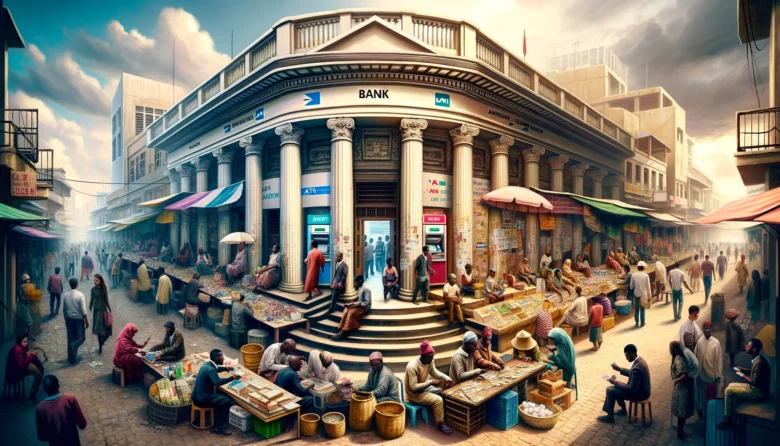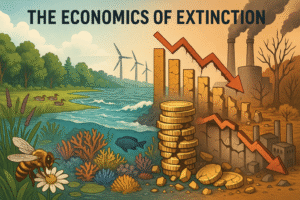Welcome to the third installment of our blog series – “Bridging Worlds: Formal and Informal Finance Merge“
Picture yourself navigating through the vibrant streets of an emerging economy. The air buzzes with the sounds of commerce and chatter, and every corner reveals a blend of old and new. There, standing proudly, is a sleek bank, its modern facade promising security and growth. Just a few steps away, under the shade of an ancient tree, a group of locals engage in a practice as old as time—informal lending.
This scene paints a vivid picture of the financial ecosystem in emerging economies, where traditional banking systems and grassroots financial practices coexist and interact in complex ways. This duality forms the backbone of economic activity, offering diverse financial solutions to meet the needs of all community members. As we delve into this world, we’ll explore the intricate dance between formal and informal finance sectors, uncovering their impact on economic development and individual livelihoods.
Understanding Formal and Informal Financial Markets
In the vast financial landscape, two main types of markets serve the populace: formal and informal.
Formal Financial Markets are the pillars of the global economy, regulated by government authorities and populated by established institutions like banks, credit unions, and investment companies. They offer a range of services, from savings accounts to loans and insurance, all under the watchful eyes of financial regulations. These markets cater to those who meet specific criteria, such as having a stable income or owning assets for collateral.

Contrastingly, Informal Financial Markets thrive on the periphery of these regulated spaces. Unbound by formal rules and often overlooked by policymakers, these markets offer vital financial services to those who might not have access to traditional banking. From the moneylender who provides a loan to a small vendor, to the rotating savings and credit associations (ROSCAs) that allow community members to pool resources, these informal systems are built on trust, community ties, and an intimate understanding of local needs.
The coexistence of these markets is not merely a matter of financial access but reflects deeper socio-economic dynamics. Formal markets often represent the structured, visible side of the economy, while informal markets reveal the resilience and adaptability of communities working within or beyond the formal boundaries. Together, they form a complex ecosystem that supports a wide range of economic activities, from large enterprises to small, family-run businesses. Understanding how these markets interact is key to grasping the nuances of economic development in emerging economies, setting the stage for a fascinating exploration of their synergies and frictions.
Insights from Ngalawa & Viegi (2013)
Diving into the heart of our financial exploration, the study by Ngalawa & Viegi in 2013 serves as a guiding light. This comprehensive research peels back the layers of the financial ecosystem in emerging economies, revealing a dynamic interplay between formal and informal sectors. The study meticulously analyzes how the expansion of formal banking impacts the traditional, informal lending practices that have served communities for generations. Imagine a scenario where the opening of a new bank branch in a small town suddenly shifts the financial landscape.

Informal lenders, who once were the sole providers of credit, find themselves adjusting their interest rates or the terms of their loans to stay competitive. This adjustment isn’t just about numbers; it’s about maintaining relationships and trust within the community. Ngalawa & Viegi’s work uncovers the ripple effects of such changes, highlighting how formal financial inclusion strategies can inadvertently influence the fabric of informal financial networks. Their insights shed light on the delicate balance between fostering financial inclusion and preserving the informal networks that have been lifelines for many.
The Complementary and Competitive Nature of Financial Sectors
The relationship between formal and informal financial markets is akin to a dance, where each step of one partner influences the movement of the other. On the one hand, these sectors are complementary. Formal financial institutions bring structured financial services, offering security and opportunities for larger investments that informal networks might not provide. For instance, a small business owner might rely on informal loans for day-to-day operations but turn to a bank for a significant investment to expand their business.

On the other hand, the competition between these sectors sparks innovation and adaptation. As formal banks extend their reach into previously underserved areas, informal lenders are pushed to redefine their value proposition. Perhaps they offer more flexible repayment terms or rely on personal relationships to offer services that are more tailored to individual needs. This competition can lead to better services and more choices for consumers, ultimately enriching the financial ecosystem.
However, this dance is delicate. The competitive push from formal institutions can pressure informal networks, potentially jeopardizing the very systems that many depend on for their financial needs. At the same time, the presence of informal lenders challenges banks to innovate and adapt, to become more inclusive and responsive to local needs. This complex interplay between complementarity and competition underlines the importance of thoughtful financial policies that foster inclusivity while protecting the diverse financial practices that coexist in emerging economies.
Challenges and Opportunities for Policy-makers
Navigating the intricate web of formal and informal financial sectors presents both challenges and opportunities for policy-makers in emerging economies. The main challenge lies in crafting policies that support the growth and integration of these diverse financial systems without stifling the unique benefits each brings to the economic table. For instance, how do you regulate informal lenders without stripping away the flexibility and accessibility that make them so vital to underserved communities? Or, how do you encourage formal financial institutions to expand their services in a way that complements rather than competes with informal networks?

On the flip side, this complex landscape is ripe with opportunities for innovative policy-making. By recognizing the strengths of both formal and informal sectors, policy-makers can develop strategies that encourage collaboration between them. This could mean creating regulatory frameworks that acknowledge the role of informal lenders, offering them pathways to legitimacy that don’t compromise their operational flexibility. Alternatively, policies could incentivize formal financial institutions to develop products and services tailored to the needs of those traditionally reliant on informal finance, such as microloans with less stringent collateral requirements or mobile banking services that reach remote communities.
The ultimate goal is to create a financial ecosystem that is both robust and inclusive, where formal and informal sectors not only coexist but thrive together, driving economic development and improving financial access for all.
Looking Ahead: Bridging Gaps for Inclusive Growth
As we gaze into the future, the potential for bridging the gaps between formal and informal financial sectors in emerging economies shines bright. The key to unlocking this potential lies in harnessing technology, fostering innovation, and crafting inclusive policies that recognize the value and needs of both sectors. Imagine a world where digital platforms enable informal lenders to record transactions securely, enhancing their credibility without losing their essence of flexibility and personal touch. Or envision policies that encourage formal financial institutions to partner with informal networks, leveraging their deep community ties to extend financial inclusion further than ever before.

The journey towards such an integrated financial ecosystem is filled with challenges, but the rewards—economic resilience, enhanced financial access, and inclusive growth—are well worth the effort. By valuing the diversity of financial practices and striving for policies that embrace this diversity, emerging economies can pave the way for a future where finance is truly for everyone. This future isn’t just a dream; it’s a possibility within reach, driven by the collective efforts of communities, financial institutions, and policy-makers working together to bridge divides and build pathways to prosperity.
Author’s Note
In this third installment of our series, we’ve explored the intricate dance between formal and informal financial sectors in emerging economies. Our goal is to illuminate the complexities and potential of this relationship, sparking conversation and thought on how to harness it for broader economic empowerment.
G.C., Ecosociosphere contributor.
Further Reading and References:
- “Portfolios of the Poor: How the World’s Poor Live on $2 a Day” by Daryl Collins, Jonathan Morduch, Stuart Rutherford, and Orlanda Ruthven.
- “The Mystery of Capital: Why Capitalism Triumphs in the West and Fails Everywhere Else” by Hernando de Soto.
- “Banker To The Poor: Micro-Lending and the Battle Against World Poverty” by Muhammad Yunus.





Comments
I don’t think the title of your article matches the content lol. Just kidding, mainly because I had some doubts after reading the article.
Can you be more specific about the content of your article? After reading it, I still have some doubts. Hope you can help me.
Thank you for your sharing. I am worried that I lack creative ideas. It is your article that makes me full of hope. Thank you. But, I have a question, can you help me?
I don’t think the title of your article matches the content lol. Just kidding, mainly because I had some doubts after reading the article.
Your article helped me a lot, is there any more related content? Thanks!
Can you be more specific about the content of your article? After reading it, I still have some doubts. Hope you can help me.
Your article helped me a lot, is there any more related content? Thanks!
Your point of view caught my eye and was very interesting. Thanks. I have a question for you. https://www.binance.info/si-LK/register?ref=V2H9AFPY